Home
Valerian
Publius Licinius Valerianus, nicknamed 'colobius' (undershirt), came from a Roman senatorial family. As an ex consul he was a negotiator between the senat and Gordian I Africanus during the revolt against the emperor Maximinus. In 251 he was selected by the emperor Decius for a high office. This office was probably not the office of censor, as sometimes mentioned by some authors. It is more probable that Decius asked him to keep an eye on his remaining family and gave him control of the financial side of the empire while he himself and his son Herennius went of to war against the Goths. Under the emperor Gallus Valerian had an important post in Raetia. When Aemilian took the power in Moesia Superior the emperor Gallus called upon Valerian to mobilise the Celtic and Germanic legions and attack Aemilian. Valerian probably learned that Aemilian had departed for Rome to confront Gallus so he probably first brought the remaining troops in Moesia under his control and later those in Dacia. This way he prevented to be attacked in the rear by the remainder of the legions that had backed Aemilian. The coinage in the name of Aemilian was then seized in the mints of Viminacium and Dacia. In the beginning of the confrontation with Aemilian, around june/july 253, the emperor Gallus and his son Volusian were killed by their own troops. When the news of their deaths reached Valerian and his army the soldiers under his command proclaimed him emperor against Aemilian. His son Gallienus was probably not immediately proclaimed co-emperor but received some sort of semi-official status as Caesar. Soon after his proclamation the mint of Viminacium struck sestertii with the local year XIV in the name of Valerian but also an emission of silver antoniniani to reward the legions and to gain their support. After that he marched against Aemilian who was killed by his own troops around august/september 253. With Aemilian out of the way the senat gladly accepted Valerian as their emperor and his son Gallienus was made co-emperor. Somewhere during the second half of the year 256 Gallienus eldest son Valerian was proclaimed Caesar. Soon it was decided that Valerian would take up the defense of the eastern half of the empire and Gallienus the western half. Both emperors did not get an easy job. Gallienus constantly had to wage war against intruding Germanic tribes, Alemannen and Franks. In the east an invasion of the Goths was halted thanks to a general named Succesianus. This earned him the office of Pretorian prefect at the side of the emperor Valerian. With his help Valerian started to rebuild Syria which was defastated after the Persian attack in late 252 or early 253. Around 256 Valerian managed to stop a new Persian invasion but could not prevent the fall and destruction of Dura-Europos. During the summer of 260 the Persians attacked again and Valerian set out on a campaign against them when he was taken prisoner near Edessa by Shapur I, king of the Persians. The story goes that he was captured during negotiations but also that he was betrayed by Macrinus, one of his own high ranking officers. There are also a lot of stories about what happened to him in captivity. Shapur I supposedly used him as a footstool and humiliated him in every possible way. As a result of the torments Valerian died after which he was skinned. His skin was then painted red, filled with straw en put on display in a Persian temple to serve as a sightshow for the guests of Shapur. The downfall of Valerian shook the Roman world. The Persians once again raided Syria and took the city of Antioch a second time. Finally Macrianus, with the help of a general called Callistus and the ruler of the dessert city Palmyra named Odenathus, managed to drive the Persians back behind the Eufrate river. For a short while Gallienus was accepted in the east as sole ruler but soon after that Macrianus took the power and managed to get his sons Macrianus Junior and Quietus proclaimed emperors by the army.
The coins of Valerian from Viminacium
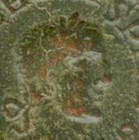 |
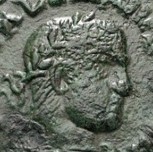 |
 |
 |
Denominations struck: sestertii.
On the sestertii the emperor has a portrait with laurel wreath.
Used notations of the local year:
AN
XIV, used from may/june 253 until july 253.
AN
XV, used from july 253 until july 254.
AN XVI, used july 254 until july 255.
Obverse text variations used:
A:
IMP VALERIANVS P F AVG
B: IMP P LIC VALERIAIO AVG
C: IMP VALERIANVS P AVG
Reverse text variations used:
a:
PMSC - OLVIM
b: PMS - COLV
AN XVI |
|
| Sestertius ANNO XVI - 254/255 - Pick 190 var. - Martin 7.06.5 - Varbanov 237 | |
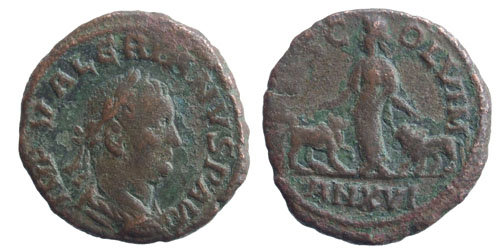 |
Private collection Weight: 10,93 grams Diameter: 26,7 mm |
Obverse: Bust of Valerian to the right with laurel wreath, part of paludamentum visible over the shoulders. Text: (C:) IMP VALERIANVS P AVG (IMPERATOR VALERIANVS PIVS AVGVSTVS) - Emperor Valerian, dutiful and fortunate Augustus. Reverse: Woman (Moesia) standing with head to the left holding her right hand over a bull and her left hand over a lion. Text: (a:) PMSC - OLVIM (PROVINCIA MOESIA SVPERIOR COLONIA VIMINACIVM) - Province Moesia Superior Colony Viminacium. Exergue: AN XVI (ANNO XVI) - year 16 (255/256). Remark: For a sestertius of Valerian this specimen is very well made with a good portrait of the emperor. |
|
| Sestertius ANNO XVI - 254/255 - Pick 190 var. - Martin 7.06.5 - Varbanov 237 | |
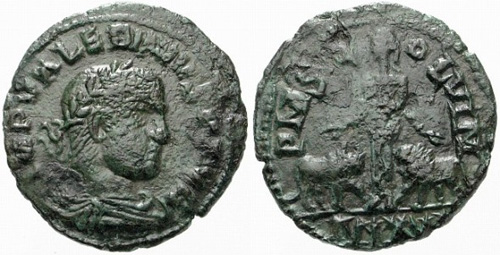 |
Collection Scott Sexton on Tantalus coin registry Weight: 9,50 grams Diameter: 27 mm |
Obverse: Bust of Valerian to the right with laurel wreath, part of paludamentum visible over the shoulders. Text: (C:) IMP VALERIANVS P AVG (IMPERATOR VALERIANVS PIVS AVGVSTVS) - Emperor Valerianus, dutiful and fortunate Augustus. Reverse: Woman (Moesia) standing with head to the left holding her right hand over a bull and her left hand over a lion. Text: (a:) PMSC - OLVIM (PROVINCIA MOESIA SVPERIOR COLONIA VIMINACIVM) - Province Moesia Superior Colony Viminacium. Exergue: AN XVI (ANNO XVI) - year 16 (255/256). Remark: The legends of this specimen are identical from those on the previous coin but the overall finishing of the coin is much poorer. However the bust of Valerian does have a nice visible paludamentum. The letters and numerals in the exergue on the reverse have strange star shaped edges. |
|
| Sestertius ANNO XVI - 254/255 - Pick 190 var. - Martin 7.06.1 - Varbanov - (Verg. 237) | |
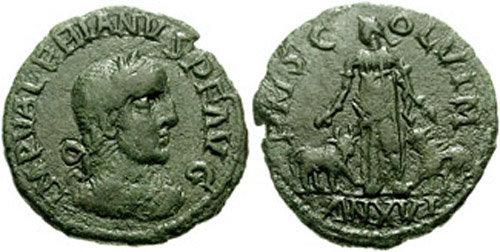 |
Copyright Classical Numismatic Group Weight: 8,16 grams Diameter: 26 mm |
Obverse: Bust of Valerian to the right with laurel wreath, part of paludamentum visible over the shoulders. Text: (A:) IMP VALERIANVS P F AVG (IMPERATOR VALERIANVS PIVS FELIX AVGVSTVS) - Emperor Valerianus dutiful and fortunate Augustus. Reverse: Woman (Moesia) standing with head to the left holding her right hand over a bull and her left hand over a lion. Text: (a:) PMSC - OLVIM (PROVINCIA MOESIA SVPERIOR COLONIA VIMINACIVM) - Province Moesia Superior Colony Viminacium. Exergue: AN XVI (ANNO XVI) - jaar 16 (255/256). Opmerking: The letters E and R in the name VALERIANVS resemble very much a letter B. |
|
| Sestertius ANNO XVI - 254/255 - Pick 190 var. - Martin 7.06.1 - Varbanov - (Verg. 236) | |
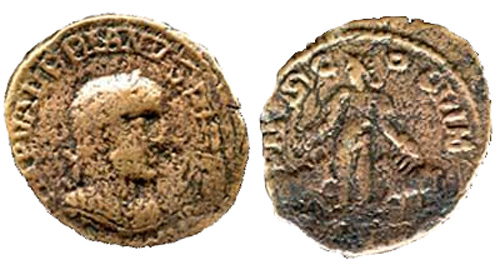 |
Collection bruce 61813 on
Tantalus coin registry Weight: 12,30 grams Diameter: 30 mm |
Obverse: Bust of Valerian to the right with laurel wreath, part of paludamentum visible over the shoulders. Text: (A:) IMP VALBBIANVS P F AVG (IMPERATOR VALERIANVS PIVS FELIX AVGVSTVS) - Emperor Valerianus dutiful and fortunate Augustus. Reverse: Woman (Moesia) standing with head to the left holding her right hand over a bull and her left hand over a lion. Text: (a:) PMSC - OLVIM (PROVINCIA MOESIA SVPERIOR COLONIA VIMINACIVM) - Province Moesia Superior Colony Viminacium. Exergue: AN XVI (ANNO XVI) - jaar 16 (255/256). Remark: Specimen looking like the previous type but made with very bad dies. The letters E and R in the name VALERIANVS resemble very much the letter B and also the letter I has a strange shape. Moesia is also strangely depicted. |
|
| Sestertius ANNO XVI - 254/255 - Pick 189 - Martin 7.03 var. - Varbanov 236 | |
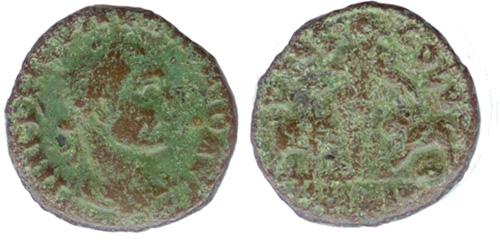 |
Collection Scott Sexton on Tantalus coin registry Weight: 7,71 grams Diameter: 24 mm |
Obverse: Bust of Valerian to the right with laurel wreath, part of paludamentum visible over the shoulders. Text: (B:) IMP P LIC VALERIAIO AVG (IMPERATOR PVBLIVS LICINIVS VALERIAIO AVGVSTVS) - Emperor Publius Licinius Valerianus Augustus. Reverse: Woman (Moesia) standing with head to the left holding her right hand over a bull and her left hand over a lion. Text: (b:) PMS - COLV (PROVINCIA MOESIA SVPERIOR COLONIA VIMINACIVM) - Province Moesia Superior Colony Viminacium. Exergue:AN XVI (ANNO XVI) - jaar 16 (255/256). Remark: The die cutter made a mistake in the name VALERIANO and cut it as VALERAIO. On the reverse the legend is abreviated to PMS- COLV. |
|